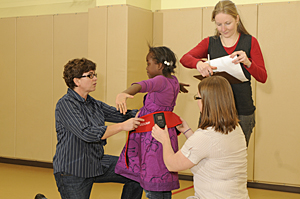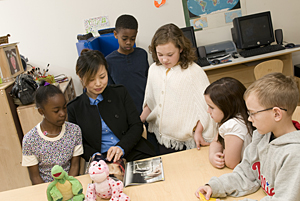

- Rozovsky wins prestigious NSF Early Career Award
- UD students meet alumni, experience 'closing bell' at NYSE
- Newark Police seek assistance in identifying suspects in robbery
- Rivlin says bipartisan budget action, stronger budget rules key to reversing debt
- Stink bugs shouldn't pose problem until late summer
- Gao to honor Placido Domingo in Washington performance
- Adopt-A-Highway project keeps Lewes road clean
- WVUD's Radiothon fundraiser runs April 1-10
- W.D. Snodgrass Symposium to honor Pulitzer winner
- New guide helps cancer patients manage symptoms
- UD in the News, March 25, 2011
- For the Record, March 25, 2011
- Public opinion expert discusses world views of U.S. in Global Agenda series
- Congressional delegation, dean laud Center for Community Research and Service program
- Center for Political Communication sets symposium on politics, entertainment
- Students work to raise funds, awareness of domestic violence
- Equestrian team wins regional championship in Western riding
- Markell, Harker stress importance of agriculture to Delaware's economy
- Carol A. Ammon MBA Case Competition winners announced
- Prof presents blood-clotting studies at Gordon Research Conference
- Sexual Assault Awareness Month events, programs announced
- Stay connected with Sea Grant, CEOE e-newsletter
- A message to UD regarding the tragedy in Japan
- More News >>
- March 31-May 14: REP stages Neil Simon's 'The Good Doctor'
- April 2: Newark plans annual 'wine and dine'
- April 5: Expert perspective on U.S. health care
- April 5: Comedian Ace Guillen to visit Scrounge
- April 6, May 4: School of Nursing sponsors research lecture series
- April 6-May 4: Confucius Institute presents Chinese Film Series on Wednesdays
- April 6: IPCC's Pachauri to discuss sustainable development in DENIN Dialogue Series
- April 7: 'WVUDstock' radiothon concert announced
- April 8: English Language Institute presents 'Arts in Translation'
- April 9: Green and Healthy Living Expo planned at The Bob
- April 9: Center for Political Communication to host Onion editor
- April 10: Alumni Easter Egg-stravaganza planned
- April 11: CDS session to focus on visual assistive technologies
- April 12: T.J. Stiles to speak at UDLA annual dinner
- April 15, 16: Annual UD push lawnmower tune-up scheduled
- April 15, 16: Master Players series presents iMusic 4, China Magpie
- April 15, 16: Delaware Symphony, UD chorus to perform Mahler work
- April 18: Former NFL Coach Bill Cowher featured in UD Speaks
- April 21-24: Sesame Street Live brings Elmo and friends to The Bob
- April 30: Save the date for Ag Day 2011 at UD
- April 30: Symposium to consider 'Frontiers at the Chemistry-Biology Interface'
- April 30-May 1: Relay for Life set at Delaware Field House
- May 4: Delaware Membrane Protein Symposium announced
- May 5: Northwestern University's Leon Keer to deliver Kerr lecture
- May 7: Women's volleyball team to host second annual Spring Fling
- Through May 3: SPPA announces speakers for 10th annual lecture series
- Through May 4: Global Agenda sees U.S. through others' eyes; World Bank president to speak
- Through May 4: 'Research on Race, Ethnicity, Culture' topic of series
- Through May 9: Black American Studies announces lecture series
- Through May 11: 'Challenges in Jewish Culture' lecture series announced
- Through May 11: Area Studies research featured in speaker series
- Through June 5: 'Andy Warhol: Behind the Camera' on view in Old College Gallery
- Through July 15: 'Bodyscapes' on view at Mechanical Hall Gallery
- More What's Happening >>
- UD calendar >>
- Middle States evaluation team on campus April 5
- Phipps named HR Liaison of the Quarter
- Senior wins iPad for participating in assessment study
- April 19: Procurement Services schedules information sessions
- UD Bookstore announces spring break hours
- HealthyU Wellness Program encourages employees to 'Step into Spring'
- April 8-29: Faculty roundtable series considers student engagement
- GRE is changing; learn more at April 15 info session
- April 30: UD Evening with Blue Rocks set for employees
- Morris Library to be open 24/7 during final exams
- More Campus FYI >>
Editor's note: This is the first in a series of articles about research taking place at the Early Learning Center, The College School, and the University of Delaware Laboratory Preschool. Housed in the College of Education and Public Policy, these centers provide valuable services to children and families in the region, but they also play an important role in the academic mission of the University.
More than 400 UD students from every college are involved in these centers each year as observers, lesson planners, student teachers, mentors, and researchers. Faculty and graduate students from across the University use the centers as "living laboratories" for studies on topics ranging from social and emotional development, to physical therapy, to early literacy.
In the fall of 2009, the Laboratory Preschool and The College School will join the Early Learning Center at the University's complex on Wyoming Road in Newark in new, expanded facilities that will provide a state-of-the-art resource for groundbreaking research and educational excellence.
1:44 p.m., June 30, 2009----The preschoolers at the University of Delaware's Early Learning Center (ELC) and the first- through eighth-graders in The College School (TCS) are contributing to the development of new knowledge that may help to solve the growing problem of childhood obesity in America.
Professors Nancy Getchell and Jaehee Jung are investigating very different aspects of this complex problem, but both have taken advantage of the “living laboratory” provided by the ELC and TCS to gather data for their research.
Getchell is studying the relationship between motor competency and physical fitness in preschoolers, while Jung is exploring body dissatisfaction and patterns of media use among preadolescents.
“There's a general assumption that very young children get all the exercise they need by just running around,” says Getchell, who is an associate professor in the Department of Health, Nutrition and Exercise Sciences. “But this turns out not to be true. What we've found is that they do much better with structured physical activity.”
Getchell and Sam Logan, who completed a master's degree in exercise science in 2008, administered a motor proficiency test to a group of preschoolers and measured their body composition to determine whether there was a relationship between the two factors.
While they found that the relationship was not statistically significant when the data were analyzed for the entire subject pool, it was significant when the children were broken down into groups. “What we discovered,” says Getchell, “was that the group with the highest body fat had the lowest level of motor proficiency.”
“What we're concerned about,” she says, “is the spiraling effect. Children who don't develop early motor competency tend to become less active over time, resulting in even lower proficiency and an increased risk of obesity. The relationship becomes stronger as kids get older.”
Getchell's work in this area is ongoing. She is currently working with Ilaria Masci, an exchange student from the University of Rome, on the development of improved ways to measure motor proficiency and energy expenditure in this age group.
Getchell is also planning a series of studies during her sabbatical next spring, which she will spend at the University of Otago in New Zealand. “I'm hoping to learn more about physical factors and obesity across the lifespan,” she says.
Getchell has found the ELC to be the “ideal environment” for her work. “The center doesn't have a physical education program,” she says, “so I've developed one that I administer through my students. It's a very nice reciprocal arrangement -- the ELC students have a PE program, my students gain valuable experience from running the program and seeing how the children develop over the course of the semester, and I can control the type and level of activity within the program so that I can get meaningful results for my research.”
While Getchell's overall research interests center on the development of motor skills, Jung's interests focus on the psychological, social, and cultural issues associated with obesity. An associate professor in the Department of Fashion and Apparel Studies, Jung recently studied a group of 50 boys and girls, ages 8 to 11, to determine their level of satisfaction with their own bodies as well as their media consumption and image perception patterns.
The results of the study, carried out in collaboration with Michael Peterson, professor in UD's Department of Health, Nutrition and Exercise Sciences, were reported in Family and Consumer Sciences Research Journal.
The children's height and weight were measured to determine their body mass index (BMI), and they were interviewed about their media consumption behaviors -- that is, frequency, content, and preferences for a variety of media including TV, magazines, and video games. The children were also shown two pictorial test instruments and then asked to respond to questions about their body size perceptions and preferences for their own sex as well as for the opposite sex.
“We found marked differences between boys and girls in their ideal body preferences,” Jung says. “The boys chose the larger images as ideals, showing a preference for body types like the figures they see in video games and action toys. On the other hand, the girls wanted to be thinner than their perceived actual body size.”
“We also found a significant difference in their patterns of media use,” she continues. “Boys showed a greater attraction toward muscular appearances and athletic ability in all media venues, whereas the girls' responses indicated a greater proclivity toward beauty and looks.”
Another interesting finding was in the children's choices of ideals for the opposite sex. “The girls chose images showing very large boys,” Jung says, “while the boys picked very skinny girls.”
Jung was also struck by the trend among girls to watch programs and read magazines, such as Cosmo Girl and Seventeen, that are targeted to older teens and young women.
“There is a huge discrepancy between the cultural ideal and the average person,” Jung says. “Kids have a hard time understanding that the images they see in the media represent only a very small percentage of people in America. This is a problem because their ideals shape their behavior, and dissatisfaction with their current body size can have a negative impact on their self-esteem. This dissatisfaction grows as they get heavier due to poor diet and lack of activity.”
“Media literacy is critical,” she adds. “We need to increase children's awareness of the deceptive aspects of media images.”
Jung is currently examining body dissatisfaction and disordered eating behaviors with early adolescent boys and girls enrolled in local middle schools and plans to share her findings with school administrators in district offices and individual schools to encourage the implementation of programs that promote healthy eating and exercise behaviors.
“Addressing this problem will involve a concerted effort that includes families, schools, and health and nutritional practitioners, as well as communities,” she says. “The concepts have to be embedded into regular programs and everyday activities.”
Article by Diane Kukich
Photos by Kathy F. Atkinson and Duane Perry


